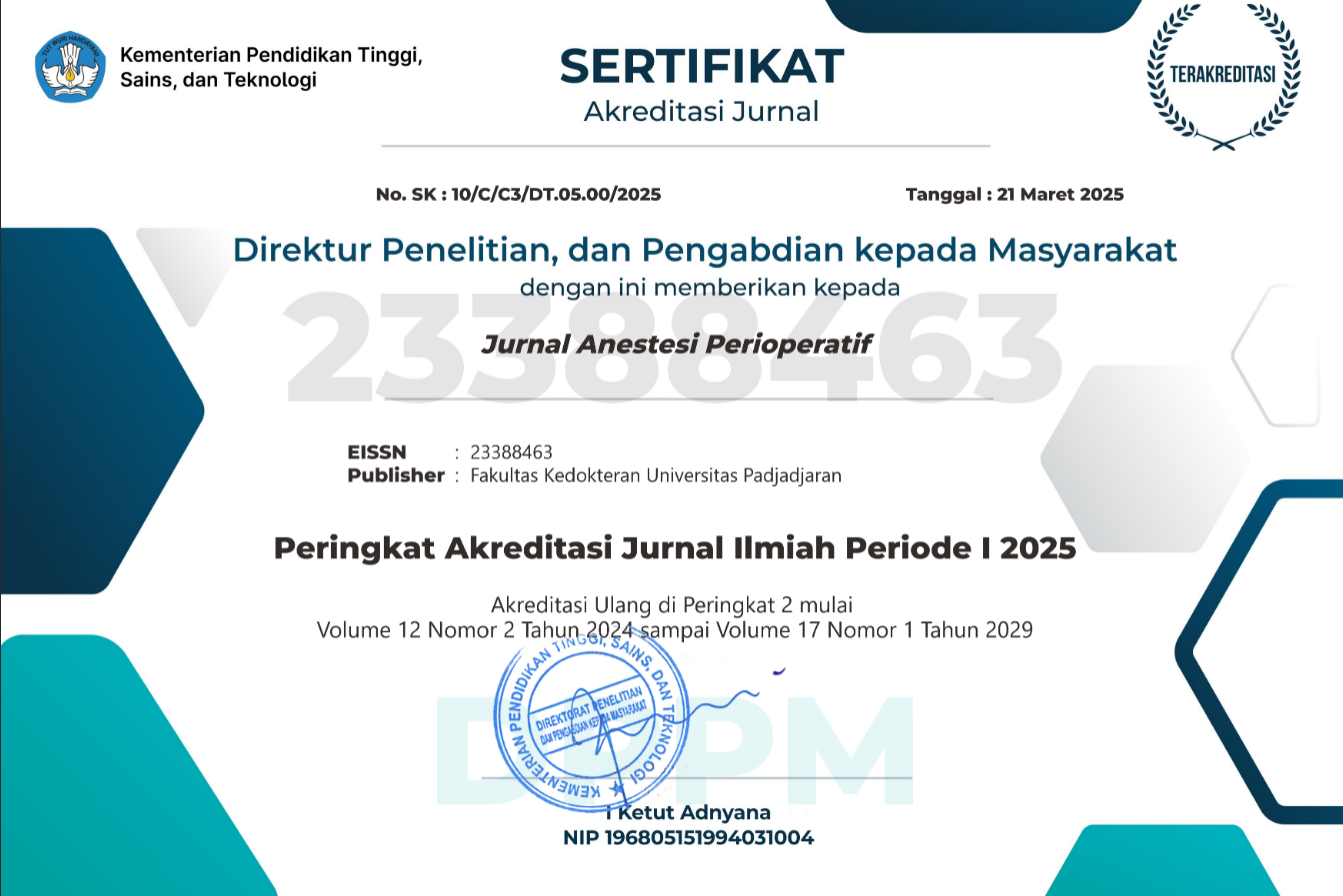Gambaran Pengetahuan Klinisi Ruang Rawat Intensif mengenai Ventilator Associated Pneumonia (VAP) Bundle di Ruang Rawat Intensif RSUP Dr. Hasan Sadikin Bandung
Abstract
Ventilator associated pneumonia (VAP) merupakan infeksi yang terjadi pada pasien yang terintubasi ≥48 jam di ruang rawat intensif. Penanganan VAP merupakan tantangan utama akibat morbiditas dan mortalitas yang tinggi.Ventilator associated pneumonia bundle (VAPb) telah terbukti dapat menurunkan angka kejadian VAP sehingga pengetahuan dokter dan perawat mengenai VAPb menentukan keberhasilan pencegahan VAP di ruang rawat intensif. Tujuan penelitian ini mengetahui pengetahuan dokter dan perawat mengenai VAPb di ruang rawat intensif RSUP Dr. Hasan Sadikin Bandung. Data diambil dari bulan November–Desember 2016. Penelitian deskriptif dengan desain potong lintang ini menggambarkan pengetahuan mengenai VAPb dari dokter residen Departemen Anestesi dan Terapi Intensif dan perawat di ruang rawat intensif RSUP Dr. Hasan Sadikin Bandung. Responden terdiri atas 79 dokter dan 88 perawat. Tingkat pengetahuan VAPb diuji menggunakan 20 pertanyaan kuesioner. Responden perawat terbanyak berjenis kelamin perempuan (74%), berusia ≥30 tahun (92%), status pendidikan diploma III (65%), lama kerja >5 tahun (76%), dan bekerja di Intensive Care Unit (ICU) (32%). Responden dokter terbanyak berjenis kelamin laki-laki (71%), berusia ≥30 tahun (83%), dan telah menyelesaikan stase ICU (61%). Simpulan, nilai kuesioner perawat dan dokter rata-rata berturut-turut 73,63 dan 73,16.
Kata kunci: Klinisi ruang rawat intensif, tingkat pengetahuan, ventilator associated pneumonoia bundle
Description of Intensive Care Clinician Knowledge about Ventilator Associated Pneumonia (VAP) Bundle in the Intensive Care Unit of Dr. Hasan Sadikin Hospital Bandung
Ventilator associated pneumonia (VAP) is an infection that occurs in patients who are intubated ≥48 hours in intensive care. Management VAP is a major challenge due to the high morbidity and mortality. Ventilator associated pneumonia bundle (VAPb) has been shown to reduce the incidence of VAP, so knowledge of doctors and nurses about VAPb determine the success of preventing VAP in intensive care. This study aims to know the description of intensive care clinician knowledge about ventilator associated pneumonia bundle in the intensive care of Dr. Hasan Sadikin General Hospital Bandung. Data were collected from November–December 2016. Descriptive study with cross-sectional design depicts VAPb knowledge of resident physicians Department of Anesthesia and Intensive Therapy and nurses in the Intensive Care Department of Dr. Hasan Sadikin Hospital. Respondents consisted of 79 doctors and 88 nurses. The level of knowledge VAPb tested using a 20 question questionnaire. Most nurse respondents were female (74%), aged ≥30 years (92%), educational status diploma III (65%), length of employment >5 years (76%), and work in Intensive Care Unit (ICU) (32%). Most physician respondents were male sex (71%), aged ≥30 years (83%), and had completed stase ICU (61%). In conclution, the mean value of the questionnaire nurses and doctors respectively 73.63 and 73.16.
Key words: Intensive care clinician, level of knowledge, ventilator associated pneumonoia bundle
Keywords
Full Text:
PDFReferences
Juneja D, Signh O, Javeri Y, Arora V, Dang R, Kaushal A. Prevention and management of ventilator associated pneumonia: a survey on current practices by Intensivists practicing in the Indian subcontinent. Indian J Anesth. 2011;55(2):122–9.
Mohamed K. Compliance with VAP bundle implementation and its effectiveness on surgical and medical sub-population in adult ICU. Egypt J Chest Dis Tuberculosis. 2014;63(1):9–14.
Ismail R, Zahran E. The Effect of nurses training on ventilator associated pneumonia (VAP) prevention bundle on VAP incidence rate at a critical care unit. J Nurs Educ Practice. 2015;5(12):42–7.
Da Silva C, Junior M. Strategies for appropriate antibiotic use in intensive care unit. Einstein. 2015;13(3):448–53.
Walkey A, Reardon C, Sulis C, Nace R, Joyce-Brady M. Epidemiology of ventilator associated pneumonia in a long-term acute care hospital. infection control and hospital epidemiology. Infect Control Hosp Epidemiol. 2009;30(4):319–25.
Pogorzelska M, Stone P, Furuya E, Perencevich E, Larson E, Goldmann D, dkk. Impact of the ventilator bundle on ventilator associated pneumonia in intensive care unit. Int J Qual Health Care. 2011;23(5):538–44.
Cal P. Ventilator associated pneumonia prevention bundle. USA: Walden University College of Health Sciences. 2015.
Al-Sayaghi K. Prevention of ventilator associated pneumonia: a knowledge survey among intensive care nurse in Yemen. Saudi Med J. 2014;35(3):269–76.
O’keefe-McCarthy S, Santiago C, Lau G. Ventilator-associated pneumonia bundled strategies: an evidence-based practice. Worldviews Evid Based Nurs. 2008;5(4):193–204.
Lim K, Kuo S, Ko W, Sheng W, Chang Y, Hong M, dkk. Efficacy of ventilator associated pneumonia care bundle for prevention of ventilator associated pneumonia in the surgical intensive care unit of a medical center. J Microbiol Immunol Infect. 2015;48(3):316–21.
Walkey A, Reardon C, Sulis C, Nace R, Joyce-Brady M. Epidemiology of ventilator associated pneumonia in a long-term acute care hospital. Infect Control Hosp Epidemiol.. 2009;30(4):319–25.
Kalanuria A, Zai W, Mirski M. Ventilator associated pneumonia in the ICU. Crit Care. 2014;18(208):1–8.
Subramanian P, Choy K, Gobal S, Mansor M, Ng K. Impact of education on ventilator associated pneumonia in the intensive care unit. Singapore Med J. 2013;54(5):281–4.
El-Khatib M, Zeineldine S, Ayoub C, Husari A, PK BK. Critical care clinicians’ knowledge of evidence-based guidelines for preventing ventilator-associated pneumonia. Am J Crit Care. 2010;19(3):272–6.
Perez-Ganda M, Munoz P, Heras C, Sanchez G, Rello J, Bouza E. Prevention of ventilator associated pneumonia:can knowledge and clinical practice be simplyassessed in a large institution? Respir Care. 2013;58(7):1213–9.
Ali N. Critical care nurses knowledge and compliance with ventilator-associated pneumonia bundle at Cairo University Hospitals. J Educ Practice. 2013;4(15):66–78.
Munro N, Ruggeiro M. Ventilator associated pneumonia bundle: reconstruction for best care. AACN Adv Crit Care. 2014;25(2):163–75.
Said A. Knowledge and practice of intensive care nurses on prevention of ventilator associated pneumonia at Muhimbili National Hospital, Dar Es Salam, Tanzania. Tanzania: Muhimbili University of Health and Allied Sciences; 2012.
Alp E, Gundogan K, Guven M, Sungur M. Assessment of risk factors for ventilator associated pneumonia in the medical Intensive Care Unit. Yogun Bakim Dergisi. 2011;2:34–8.
DOI: https://doi.org/10.15851/jap.v5n2.1108
Article Metrics
Abstract view : 4506 timesPDF - 3096 times
This Journal indexed by

JAP is licensed under a Creative Commons Attribution-NonCommercial 4.0 International License
View My Stats



